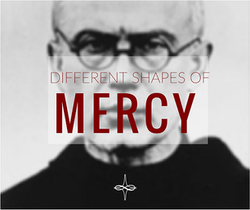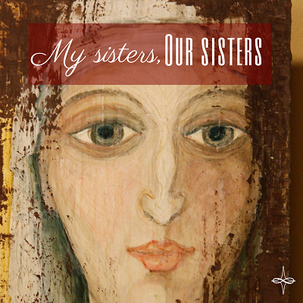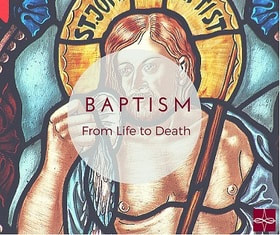|
This coming Saturday, we will celebrate the Memorial of the Passion of St. John the Baptist. St. John the Baptist was the cousin of Jesus, and is most well-known for baptizing Christ in the Jordan River. The baptism of Jesus signaled the beginning of Jesus’ public ministry. Although this Saturday we will recall St. John the Baptist’s death, by recalling his ministry of Baptism we are given the opportunity to reflect on this important sacrament.
If someone mentions baptism, I’m sure the first image we all conjure is one of a small baby, clothed in a white gown, surrounded by their parents and godparents, getting baptized. Indeed, this is the most common association of the sacrament. I’m sure most of us don’t remember our own baptisms, as our parents and godparents make baptismal promises for us and undertake the responsibility of raising us in our Catholic faith. However, infant baptism, while certainly the most recognizable form of the sacrament, is not the only point at which a person can be baptized. At the Easter Vigil, we often are witness to the baptisms of those who are entering the Church through the Rite of Christian Initiation for Adults (RCIA). These new Catholics have been preparing for months to enter the Church and receive the Sacraments of Initiation, and the joy of their baptism is evident on their faces as they are cleansed in the waters. When we are baptized, we receive symbols of our initiation into the Church community: water which cleanses us from Original Sin; a white garment demonstrating outwardly our new life in Christ; Chrism oil which strengthens us for life ahead; and a candle lit from the Easter candle symbolizing the light of Christ. These symbols of our Catholic identity are symbols that have been a part of baptism for centuries. If you’ve attended a Mass of Christian Burial, you may have noticed a reference to baptism in the funeral rite: the pall. A white cloth covers the casket of the deceased, and at the beginning of the funeral Mass, the priest notes that, “In the waters of baptism the deceased died with Christ and rose with him to new life. May he or she now share with him eternal glory” (Rites of Committal for the Order of Christian Funerals #305A). Throughout our lives, we are called to remember our baptisms, and the symbolism of a funeral pall brings us full circle from the new life we celebrate at baptism to the eternal life we attain in death. As we recall the Passion of St. John the Baptist this weekend, I invite you to take a moment to recall the baptismal promises that we make in the Rite of Baptism: Do you reject Satan? I do. And all his works? I do. And all his empty promises? I do. Do you believe in God, the Father Almighty, creator of heaven and earth? I do. Do you believe in Jesus Christ, his only Son, our Lord, who was born of the Virgin Mary was crucified, died, and was buried, rose from the dead, and is now seated at the right hand of the Father? I do. Do you believe in the Holy Spirit, the holy Catholic church, the communion of saints, the forgiveness of sins, the resurrection of the body, and life everlasting? I do.
0 Comments
“How beautiful are the footsteps of those who bring Good News” (Romans 10:15-17)! With these words of Isaiah quoted by Saint Paul, Pope Emeritus Benedict XVI warmly greeted the cardinals, bishops, and educators assembled at The Catholic University of America during his April 2008 apostolic visit to the United States. Seven years later, Pope Francis will be following in the footsteps of his predecessors as he brings the Good News to our nation. He is the fourth pontiff to do so. While the good news of Christianity itself hasn’t changed in two thousand years, its Argentine messenger is certainly electrifying the faithful with his personality of joyous humility, simplicity, and compassion evident in the course of his evangelization--specifically renewed calls to holiness and having an unreserved love of neighbor. And yet, it is all too easy to become lost in the so-called “Francis effect” (and attempts to get a papal selfie) and forget to pay attention to the message of His Holiness. A visit by the Vicar of Christ is certainly a rare occasion to be celebrated, but when it comes down to it, are we honoring the man visiting us or the One who authored the Good News in the first place?
I remember first reading the interview published by America magazine conducted by Fr. Antonio Spadaro, S.J. with the newly elected Pope Francis, desiring to hear from the man himself instead of the wild speculations and analysis drawn up by the media. To answer the first question of “Who is Jorge Mario Bergoglio?” the pope candidly responded, “I am a sinner. This is the most accurate definition. It is not a figure of speech, a literary genre. I am a sinner.” I was deeply touched to be able to identify with the earthly head of the Church in this way, thinking, “The Holy Father is a sinner… like me?!” But remaining a sinner is not what we are called to be as Christians. Accepting his election as pontiff, Pope Francis replied, “I am a sinner, but I trust in the infinite mercy and patience of our Lord Jesus Christ, and I accept in a spirit of penance.” These words are truly fitting for the “Servant of the servants of God”: a humble acceptance of God’s will and the call to give witness to His love by carrying one’s cross and serving others in imitation of Christ. We frequently see the Holy Father’s simple and charitable acts of love in global headlines. In a world so unfamiliar with loving one’s neighbor, it’s really no wonder why people find this shocking and out of the ordinary. But each of us, no matter our status, is called to give the same loving witness in our daily lives— love is our mission, after all! Remember that these acts, no matter how small, are an especially meaningful aspect of our Faith: Because Christ is the source of all our good works and is himself the truth of our faith, there is an indissoluble union between truth and love. It is the truth of our faith that guards our charitable works from becoming empty philanthropic endeavors. Our faith makes our charitable works building blocks of the Kingdom of God here on earth, blocks that can be used to build the Church on the cross of Jesus Christ. Our charitable work, on the other hand makes our faith visible and a real part of the world in which we live. The living truth of faith makes our works really good, and our good works reveal a true and living faith. (To see the full text, click here.) His Holiness is certainly aware that the eyes of the world are fixated upon his every deed. Instead of accepting the praise and lauds, he quietly continues to make each an opportunity for evangelization in the hopes of inspiring others to begin to tend to their neighbors. When Pope Francis arrives in the United States next month, remember to take the time to pray for him as he spreads the Good News, that God may grant him the strength, courage, and wisdom needed to touch hearts and that our Lady may grace him with her continued protection. Especially take the time to worship and adore the Author of Love who perpetually resides in the tabernacle of your local church— drawing near to Him requires no special security clearance, rank, or ticket, simply an open heart and a willingness to listen. Finally, pray that once Shepherd One (the name for the Air Italia plane the pope flies in) has departed for Rome, the seeds planted by His Holiness will grow to inspire us to continue the mission of love which has been entrusted to each of us. For more information on Pope Francis' Apostolic Journey to the U.S., please click here. In my own prayer this summer, I’ve been using a collection of prayers from the great American Catholic writer, Flannery O’Connor. The prayers were part of a journal that was recently found among her papers. They are the prayers of a young struggling writer who wants her faith to inform her writing and her writing to be a work of faith. The collection is called A Prayer Journal.
In one of the journal entries she is writing about the importance of a thread in writing a novel. The thread, she writes is “a view of the world behind it & the most important single item under this view of [the] world is the conception of love—divine, natural, & perverted” (O’Connor 30). She continues to reflect on how many of our great writers, Freud, Proust, Lawrence “have located love in the human & there is no need to question their location; however, there is no need either to define love as they do—only as desire, since this precludes Divine Love, which while it too may be a desire, is a different kind of desire—Divine desire—and is outside of man and capable of lifting him up to itself” (O’Connor 30). O’Connor saw this way of defining love as primarily an emotion as a real problem for the modern heart, which was becoming increasingly “divorced from faith” (O’Connor 31). She writes “The modern man isolated from faith, from raising his desire for God into a conscious desire, is sunk into the position of seeing physical love as an end in itself” (O’Connor, 31). This, though written more than 50 years ago, is at the heart of the debate today on the definition and meaning of marriage. Recently, I was asked to be part of a panel at the Catholic Information Center reflecting on the impact of the Supreme Court’s decision to legalize same-sex marriage. I was asked to address the theological and pastoral implications of the decision. One of the pastoral implications is both a challenge and an opportunity to give witness to that which makes a sacramental marriage different. I suggest what makes a sacramental marriage different is the way in which the Church understands love. As Flannery O’Connor writes, the love we are called to share in marriage is a divine love. Married love is a self-sacrificing and self-giving imitation of Jesus’ self-giving love. The married love of man and woman couple is a visible sign for the world of God’s faithful and fruitful love. What made this presentation so interesting was the centrality of defining what love means and what love has to do with marriage. Please follow this link to view the complete presentation which includes President John Garvey of The Catholic University of America and Helen Alvaré, of George Mason University. Susan Timoney is Secretary for Pastoral Ministry and Social Concerns for the Archdiocese of Washington, teaches spirituality for Saint Joseph’s College Online, and a Catholic Apostolate Center Advisor. This blog post was first published on August 9th on the St. Joseph’s College of Maine Theology Faculty Blog. Click here to learn more about our cooperative alliance with St. Joseph’s College Online.  Pope John Paul II, in his homily at the Mass he celebrated at the site of the Brzezinka (Auschwitz II) Concentration Camp in 1979; called St. Maximilian Kolbe “the patron of our difficult century.” Although the dawn of a new century has since come, St. Maximilian remains a strong symbol of Christian charity today. Seventy-four years ago tomorrow, he offered up an ultimate act of charity while knowing it would cost him his own life to save another. While Maximilian Kolbe was a prisoner at Auschwitz, several men escaped from the camp. In an attempt to deter other prisoners from trying to escape, the officers chose ten men to starve to death. When one of the men chosen expressed his anguish because he had a wife and children, St. Maximilian willingly volunteered to take his place. After two weeks without food or water, St. Maximilian was the only one of the ten still alive. At that point, he was killed by a lethal injection. Although we cannot know for certain what happened while the ten men were held in the bunker, there are reports that St. Maximilian spent much of the two weeks leading the other nine in prayer to the Blessed Mother. Most of us will not be called to make the same sacrifice as St. Maximilian did for a stranger, but God calls each of us to works of charity and mercy. The Corporal and Spiritual Works of Mercy are simple ways to love God and to love our neighbor. This might mean sacrificing your Saturday afternoon to drive an elderly neighbor to her doctor’s appointment or to volunteer at a food pantry. Mercy might take the form of comforting a coworker or classmate (regardless of whether or not you are friends) when you notice them grieving. Mercy means not honking or cursing, but instead offering up a prayer when someone cuts you off in traffic. Mercy could mean not buying another sweater when you already have ten hanging in your closet and instead donating the money to a charity for the homeless. Every act of mercy requires some sacrifice--whether you are giving up time, money, or a bit of yourself--but there is no simpler way to tell God that you love Him. St. Maximilian Kolbe, pray for us! Jennifer Beckmann is an Administrative Secretary for the United States Conference of Catholic Bishops.
Pope John Paul II, in his homily at the Mass he celebrated at the site of the Brzezinka (Auschwitz II) Concentration Camp in 1979; called St. Maximilian Kolbe “the patron of our difficult century.” Although the dawn of a new century has since come, St. Maximilian remains a strong symbol of Christian charity today. Seventy-four years ago tomorrow, he offered up an ultimate act of charity while knowing it would cost him his own life to save another.
While Maximilian Kolbe was a prisoner at Auschwitz, several men escaped from the camp. In an attempt to deter other prisoners from trying to escape, the officers chose ten men to starve to death. When one of the men chosen expressed his anguish because he had a wife and children, St. Maximilian willingly volunteered to take his place. After two weeks without food or water, St. Maximilian was the only one of the ten still alive. At that point, he was killed by a lethal injection. Although we cannot know for certain what happened while the ten men were held in the bunker, there are reports that St. Maximilian spent much of the two weeks leading the other nine in prayer to the Blessed Mother. Most of us will not be called to make the same sacrifice as St. Maximilian did for a stranger, but God calls each of us to works of charity and mercy. The Corporal and Spiritual Works of Mercy are simple ways to love God and to love our neighbor. This might mean sacrificing your Saturday afternoon to drive an elderly neighbor to her doctor’s appointment or to volunteer at a food pantry. Mercy might take the form of comforting a coworker or classmate (regardless of whether or not you are friends) when you notice them grieving. Mercy means not honking or cursing, but instead offering up a prayer when someone cuts you off in traffic. Mercy could mean not buying another sweater when you already have ten hanging in your closet and instead donating the money to a charity for the homeless. Every act of mercy requires some sacrifice--whether you are giving up time, money, or a bit of yourself--but there is no simpler way to tell God that you love Him. St. Maximilian Kolbe, pray for us! Jennifer Beckmann is an Administrative Secretary for the United States Conference of Catholic Bishops.  I was going to write this as a reflection on the life of Saint Clare, given her feast day is this week (August 11) and that there are so many interesting facts and stories about her life. Then a different, but related, reflection came to mind… Seven years ago, being a relatively recent convert to Catholicism, I had no idea who the Poor Clares were. However, I gained some new “sisters” when I started a diocesan two-year faith development program that year and was fortunate enough to have two Poor Clare nuns of the Order of St. Clare (OSC) in my class. The Poor Clares take vows of poverty, obedience, chastity, and enclosure and are followers of St. Francis and St. Clare of Assisi, living the simple, Gospel life in an enclosed contemplative community. The variety of Poor Clare expressions includes the Order of St. Clare (OSC), the Colettine Poor Clares (PCC), Capuchin Poor Clares (OSC Cap), and Poor Clares of Perpetual Adoration (PCPA). No matter the expression though, the Poor Clare life of prayer is possible because they do live in community. I am now profoundly involved with the Monastery of St. Clare in Great Falls, Montana and count the nuns of the Poor Clares of Montana, who I affectionately call my sisters, amongst my dearest friends. My sisters have taught me a few things… Sisters Maryalice, Catherine, Jane, and Judith Ann all came to Great Falls 16 years ago at the invitation of the Bishop of the Diocese of Great Falls-Billings, who wanted to bring a monastic presence to the state of Montana. Each sister came from a separate monastery of the Holy Name Federation of Poor Clares along the eastern seaboard. I did not know the sisters then, but I am in awe at their courage, tenacity, and conviction to pull-up their roots and move west to this beautiful, but unknown land, to start the first monastic presence in Montana. They did not know each other well, had never lived in Montana, and had no monastery to occupy. I have moved around a lot in my life, but my horizon was never as uncertain and rocky as was the horizon for these four amazing women. Their story on starting the first monastery in Montana echoes St. Clare, who ran away from her familiar surroundings, wealthy family, and pending marriage in 1212 to join St. Francis in a life dedicated to God. My sisters, you have taught me to trust God’s providence, discern God’s call, and follow that call with all my heart no matter how difficult the road ahead seems. In the time that I have known them, the Poor Clares of Montana have faced numerous, varying tribulations, and in each of those situations, they relied on the power of prayer (ok, no surprise there, that is their vocation – to pray, to pray with and for all of God’s people). Witnessing the sisters’ trials brings to mind St. Clare herself who faced many struggles including years of difficulty in obtaining papal approval of the form of life she and her sisters lived, a life she called “the privilege of highest poverty.” The effect of St. Clare’s prayers also come to mind as her prayers are credited with obtaining victories in turning back invaders of Assisi as well as numerous healings. My sisters, your witness to the power of prayer and reliance on Divine Providence have helped me to deepen my prayer life and ultimately my relationship with Christ. Each Poor Clare community is unique as each monastery is autonomous while expressing the Poor Clare spirit of evangelical poverty, prayer, and contemplation, and the nuns of the Poor Clares of Montana reflect St. Clare’s charisms in their own exceptional way. As a small community (the same four who were the foundresses here 16 years ago are the same four who are the community today), each nun has an enormous workload to keep the monastery running as well as to try to grow her community all while keeping her emphasis on enclosure and prayer. You would think enclosure would ensure a level of certainty, but each day is distinctive for these women. Yet, somehow, the sisters maintain their prayerful focus. What they encounter in the work of each day, likely, is not very different from what St. Clare went through in starting the Order of Poor Ladies of San Damiano over 800 years ago – all the responsibility initially falls on a few until the community can grow. My sisters, you have taught me no matter what each day brings to rely on Christ and persevere through prayer. The Poor Clares of Montana recently started offering contemplative prayer workshops and Christian meditation prayer groups, bringing the Catholic Church’s rich Desert tradition of prayer to the local laity. I am amazed that these women (all who have been involved with prayer for decades longer than I have) continue to expand and deepen their relationship with Christ by embracing various expressions of prayer, adding to their repertoire of vocal and silent prayer methods. I am reminded of St. Clare’s words, “Gaze upon Christ, consider Him, contemplate Him, as you desire to imitate Him.” My sisters, you have shown me the power of praying silently in a group as a way of cultivating my relationship with Holy Trinity, as a way of responding to God’s presence in the world. My sisters live for God alone, dedicating their whole being to God in a life expressed in community, silence, solitude, and prayer. I am grateful for their prayer, their presence, and the peace that they bring me as well as the whole community of God’s people. The Monastery of St. Clare in Great Falls is the only monastery in the state of Montana, but like the dozens of Poor Clare Monasteries in North America and the over 900 in the world, the Poor Clare nuns, following in the footsteps of St. Clare, are here for all of us – my sisters are our sisters. Thanks be to God. Fawn Waranauskas teaches in the Catholic Catechesis Certificate Program for Saint Joseph’s College Online.
This blog post was first published on August 9th on the St. Joseph’s College of Maine Theology Faculty Blog. Click here to learn more about our cooperative alliance with St. Joseph’s College Online. We walk amidst the shadows and call them life. We’re so accustomed to the dimness of this world that light is too abrasive. It burns rather than warms, offends rather than illuminates. We stumble around in the fog, thinking we are dancing. It’s like looking in the mirror and confusing the reflection with the person. Many things prevent us from truly seeing ourselves—from knowing who we are, from where we’ve come and where we are going. We’ve convinced ourselves that we are comfortable. “Comfortable” is our best friend. It doesn’t demand much of us, doesn't pry, doesn’t ask us to change. It leaves us quite alone, minds its own business. Comfortable—a makeshift refuge amidst the vast discomfort of the world we face each day. Comfortable—the often elusive goal of our lives. Comfortable—a concession to a fate that is not our true end.
Peter, James and John were comfortable in their lives before a rabbi from Nazareth invited them to drop everything and follow him. Their lives were not inherently sinful; their occupations were worthy. Life seemed good. These men were comfortable until they met the Christ who called them to something more. While the high calling Christ invited these men into was glimpsed throughout Jesus’ entire ministry, it is most fully revealed on earth in an apocalyptic way in the Transfiguration of Christ. As the Gospel tells us, soon after Peter’s profession of Jesus as the Messiah, Jesus takes Peter, James and John to the top of Mt. Tabor. Once there, Jesus is transfigured before them, “his clothes became dazzling white. Then Elijah appeared to them along with Moses, and they were conversing with Jesus (Mk 9: 3-4). His apostles are terrified. They have seen something almost greater than they could physically behold. Next, they hear the words of God the Father, “This is my beloved Son. Listen to him” (9:7). They have been confronted by light, the Eternal Light of God himself, and are roused out of any makeshift comfort they had created for themselves. The apostles were uncomfortable, puzzled, amazed. What does the Transfiguration tell us? First, that this luminous state is our destiny. As baptized Christians, we are called to be fully transfigured into Christ himself, shedding anything in our being that does not reflect his light and love. This capacity is already within us, though we diminish it with sin. Second, the Transfiguration shows us that comfortable is not enough. It is neither the goal of the Christian life, nor what we were made for. The Transfiguration instead shows us that we were made for greatness and excellence even amidst the discomfort of our world. We were never made to settle, just as we were never made for the fog, darkness or failure many people accept as daily life. Instead, Christ invites us to love. The Transfiguration is a testament to this love, for this transfigured destiny is only made possible because of his sacrifice of love on the cross. The Transfiguration is pure gift and mercy. And we can begin to be transfigured now, today. To be transfigured, we are called to imitate Christ’s love. This is an uncomfortable love that demands all of who we are. It is love that evaporates our egotism, that hurts, that pushes us out of ourselves and into the lives and well-being of others. Love that we have to practice, and will fail at, again and again. Love that is, and will be, crucified. But love that is worth it. Love that reminds us who we are and why we’re here. Love that takes us from the shadows and actually calls us to dance. Love that breaks through the fog and never diminishes. Love that is the true light. Love that transfigures. As today’s reflection from Magnificat says, “The Savior begs: ‘Become what you behold!’” Kate Flannery is the Social Media Coordinator for the Catholic Apostolate Center.  Every interaction, every conversation, each and every dive into our relational natures as human beings begins with the willing openness to listen. Listening begins with a simple opening, a knock on the door of our self-focus that lets us know that someone else is here, present before us with a unique existence, one that should be experienced and embraced. Listening happens in almost everything we do in our daily lives, whether we are speaking with others, learning instructions, praying, or even sitting alone in the quiet of an empty house. There is always something to hear, always something to experience. To listen is to see the beauty and worth in another and embrace this by joining another in his or her own life’s journey, wherever they may be, in whatever they are going through. I often say that listening is an art. We are all great artisans of speech, one way or another. Whether outspoken and personable, or soft-spoken and shy, we all have an inner preacher within us that constantly narrates our thoughts, opinions, and daily lives. To speak is in our nature, and to listen is also a part of who we are. Speaking, however, often seems easier than listening. Children, constantly having to be reminded to give each person his turn to speak, exemplify this. Why is it hard to listen? I think the life of Saint John Marie Vianney, whose feast we celebrate today, can show us some answers. Looking into his life, one can see just how important and powerful the art of listening is for us all. Listening is something that can be appreciated in others and within ourselves in an almost artistic way, such as when we read the great sonnets of Shakespeare, or admire Monet’s Water Lilies. Listening has its own beauty within it, as all things do. It is in itself a beautiful thing. Saint John Vianney, I believe, knew the power that listening wields. As a priest in the farmlands of France, traveling around to spiritually devastated towns, he would plop himself down in a confessional and just sit there, waiting. In time, townspeople started coming and speaking to him. He heard confessions for long lengths of time each day, listening to the needs of the people of France. Slowly and surely, each town he visited began beaming with a light and a warmth that didn't exist before. Besides hearing the townspeople’s confessions, John Vianney validated and embraced their lives in his own, welcoming all and listening with an open heart. He embraced fully the priesthood as a way to listen to others, to join into the community of all, to embrace and see the worth in others and to let others know that Christ sees their worth as well. He did this through devout prayer to God and a humble heart to listen to God’s plan for him. It is by this profound listening that John Vianney became the well-known Patron of Priests that he is today. John Vianney teaches us that listening can save lives. Regardless of how small a conversation may be, to listen is to embrace another, to shine forth that spirit of community that builds the foundation for the One, Holy, Catholic, and Apostolic Church. Each and every person has something to say and is worth the time. Vianney also teaches us to listen to God, to listen to the silence we so often get in response to our prayers that the answer is there, in our life. God listens to us always, in everything we do; all we need to do is learn to embrace ourselves the way God embraces us when He listens to our lives. As we continue on our journeys, I pray that the art of listening may inspire and shine beautifully in our interactions with others each day and in our prayers to the Almighty Father. William Clemens is a Undergraduate Student of Theology & Religious Studies at The Catholic University of America in Washington, D.C.
|
Details
Archives
July 2024
Categories
All
|
About |
Media |
© COPYRIGHT 2024 | ALL RIGHTS RESERVED







 RSS Feed
RSS Feed